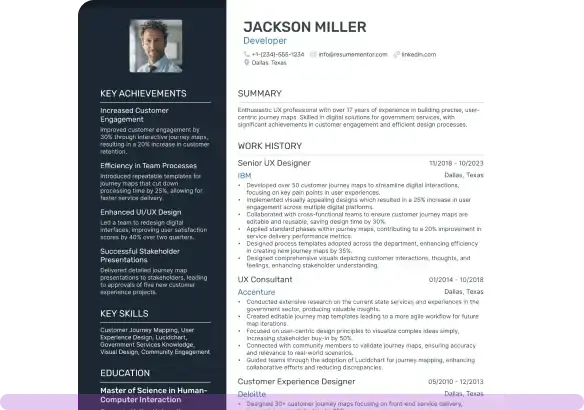Web Designer Resume Examples

Mar 31, 2025
|
12 min read
Crafting a standout web designer resume requires mastery in blending creativity with technical skills. Highlight your design journey, showcase your unique flair, and weave your story seamlessly into a digital tapestry that leaves a lasting impression.
Rated by 348 people
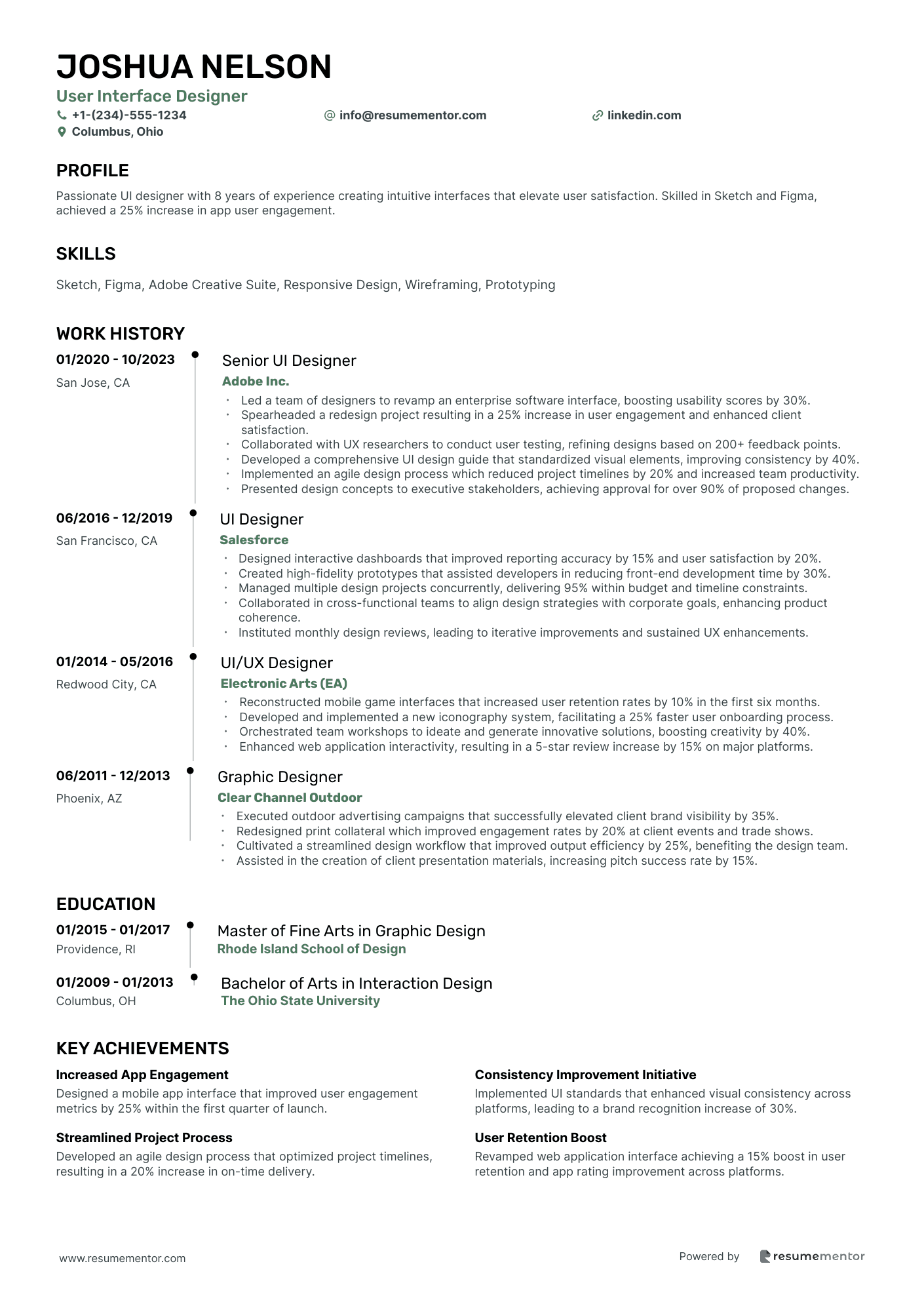
User Interface Designer
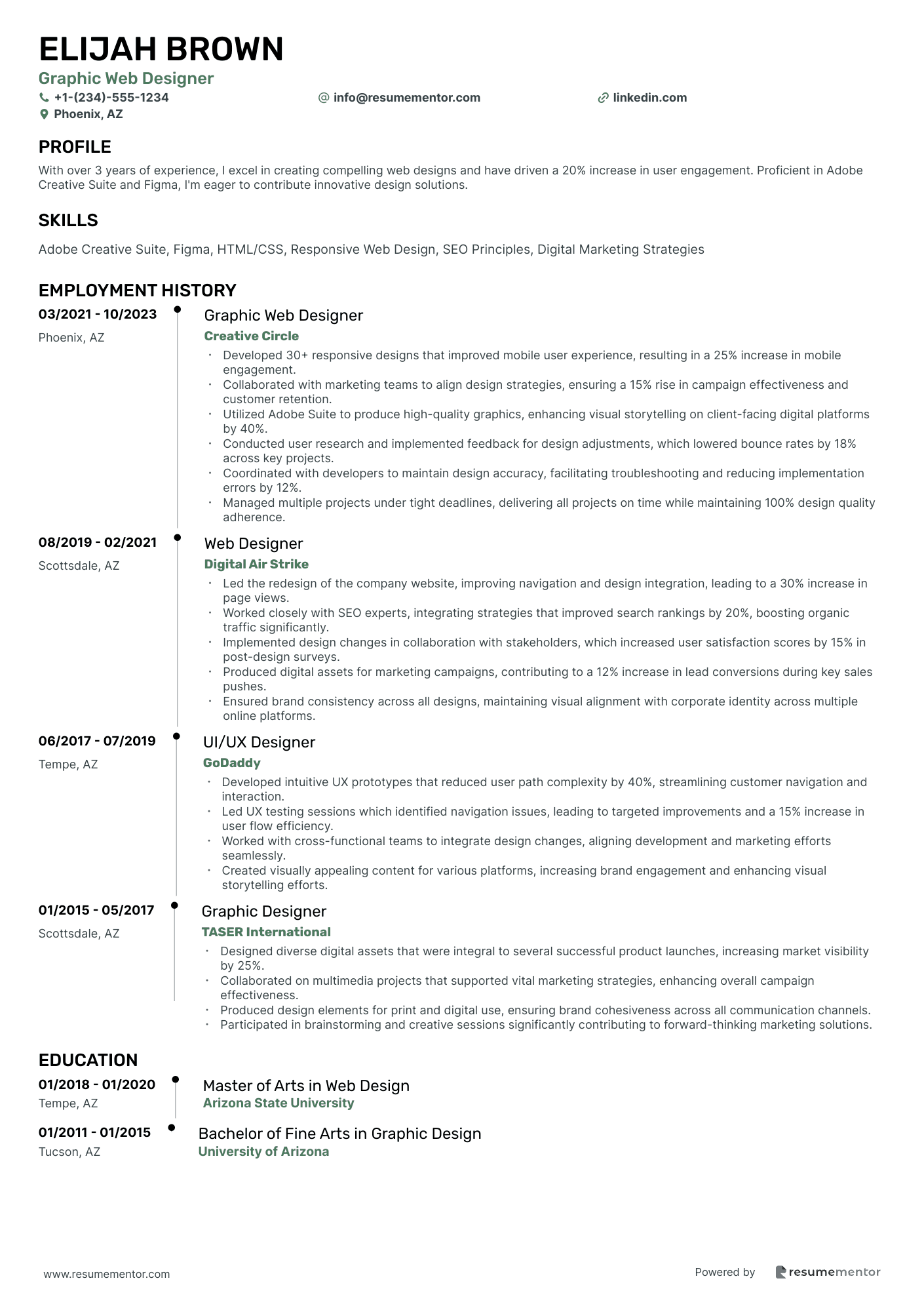
Graphic Web Designer
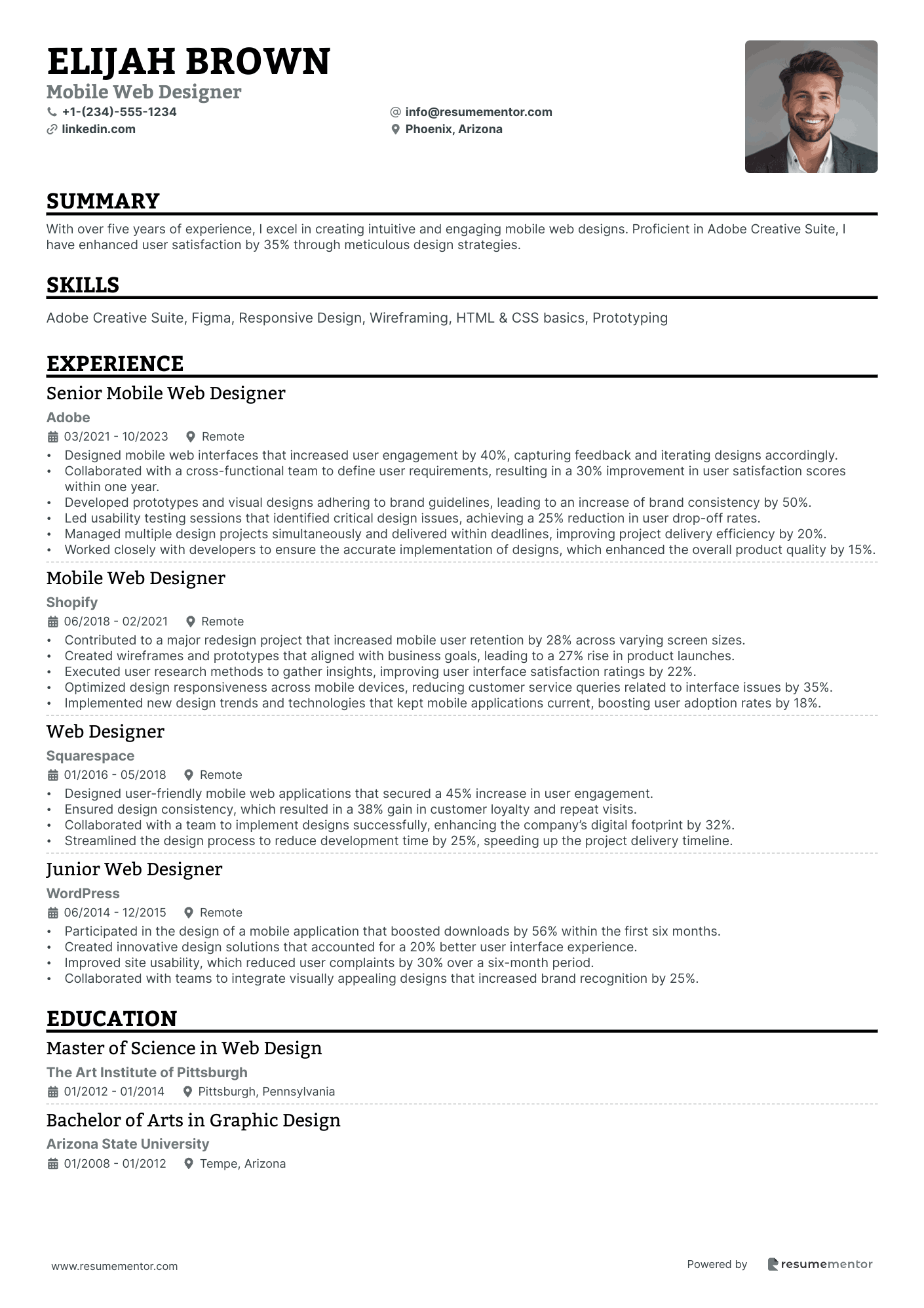
Mobile Web Designer
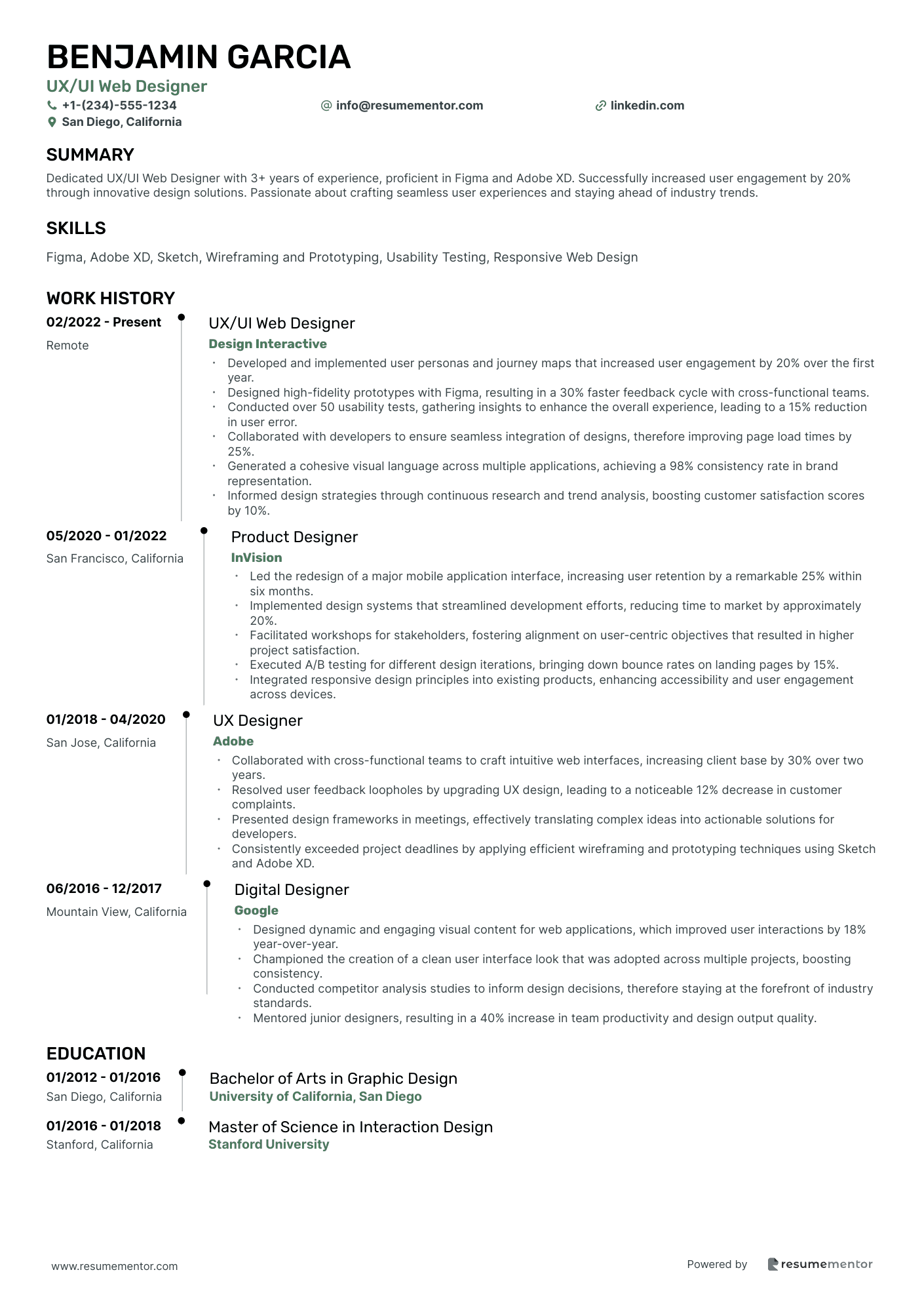
UX/UI Web Designer
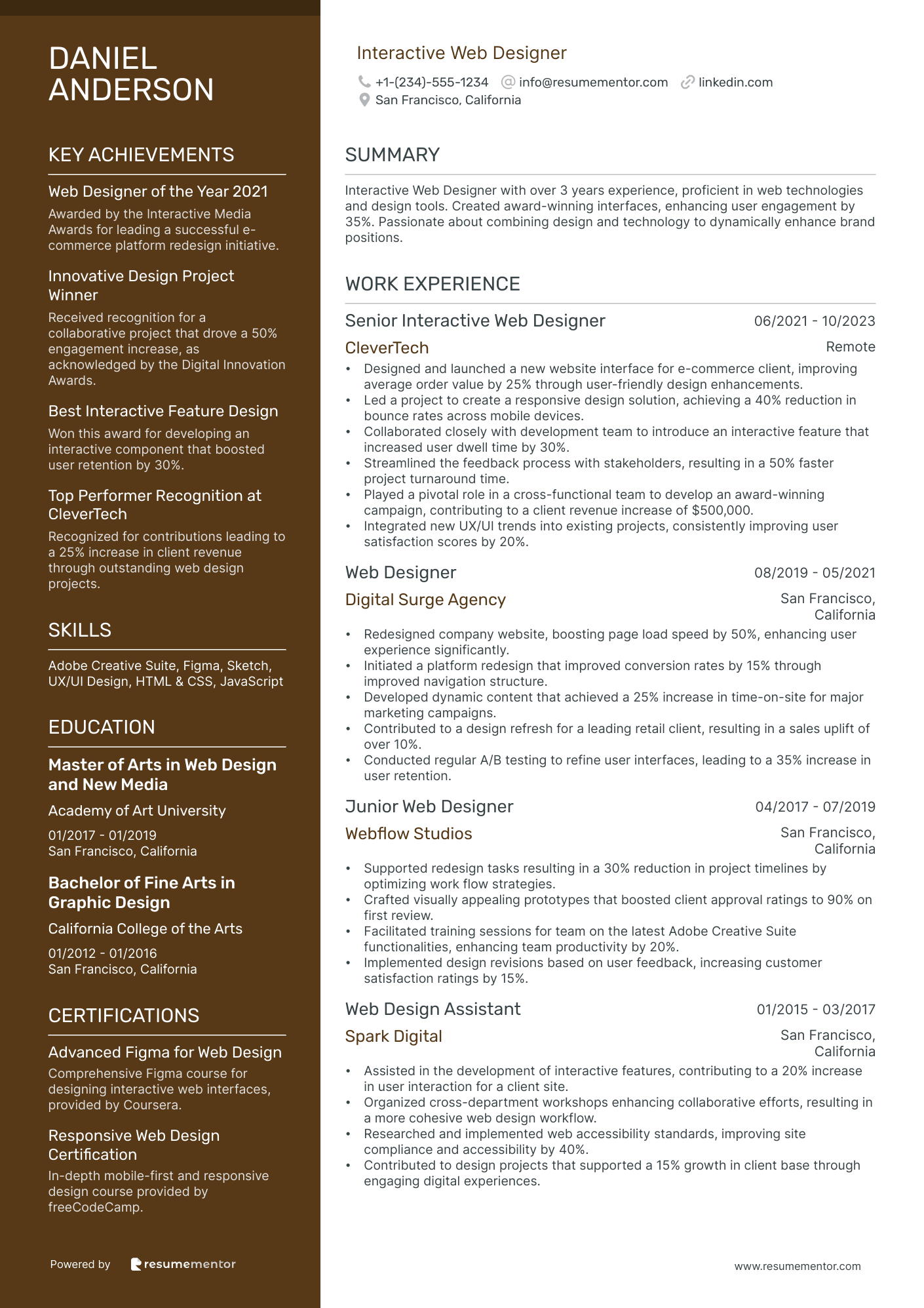
Interactive Web Designer
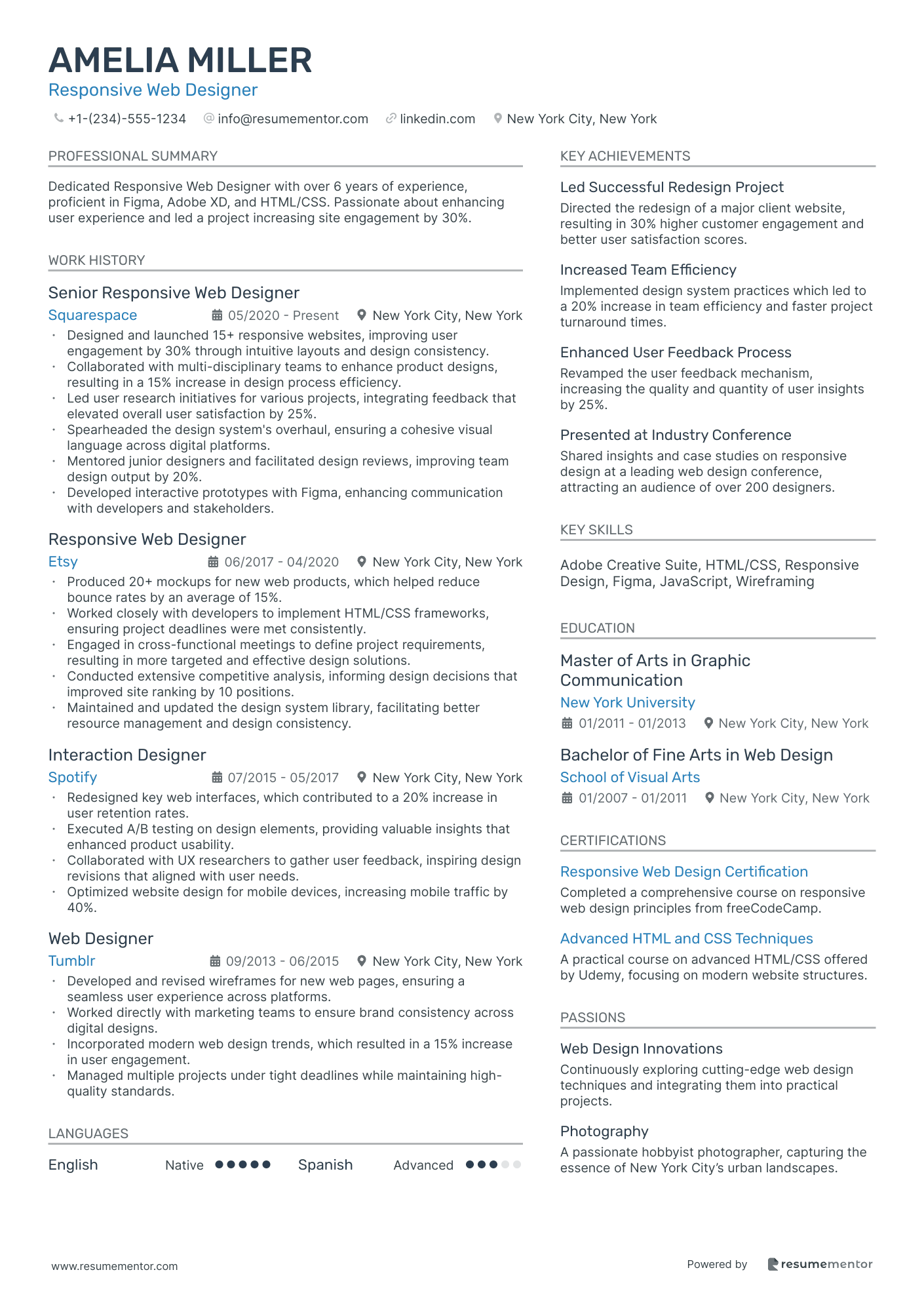
Responsive Web Designer
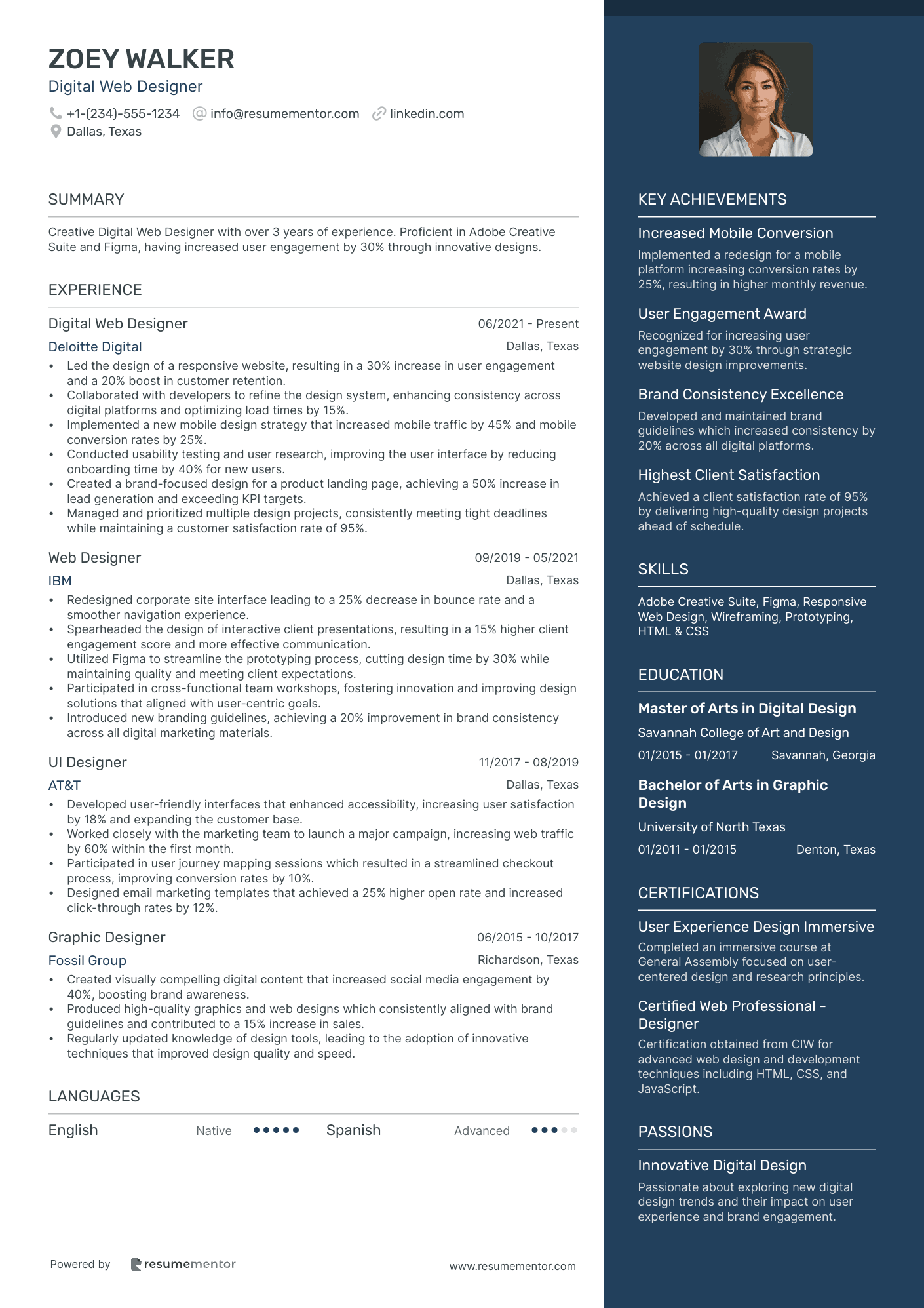
Digital Web Designer
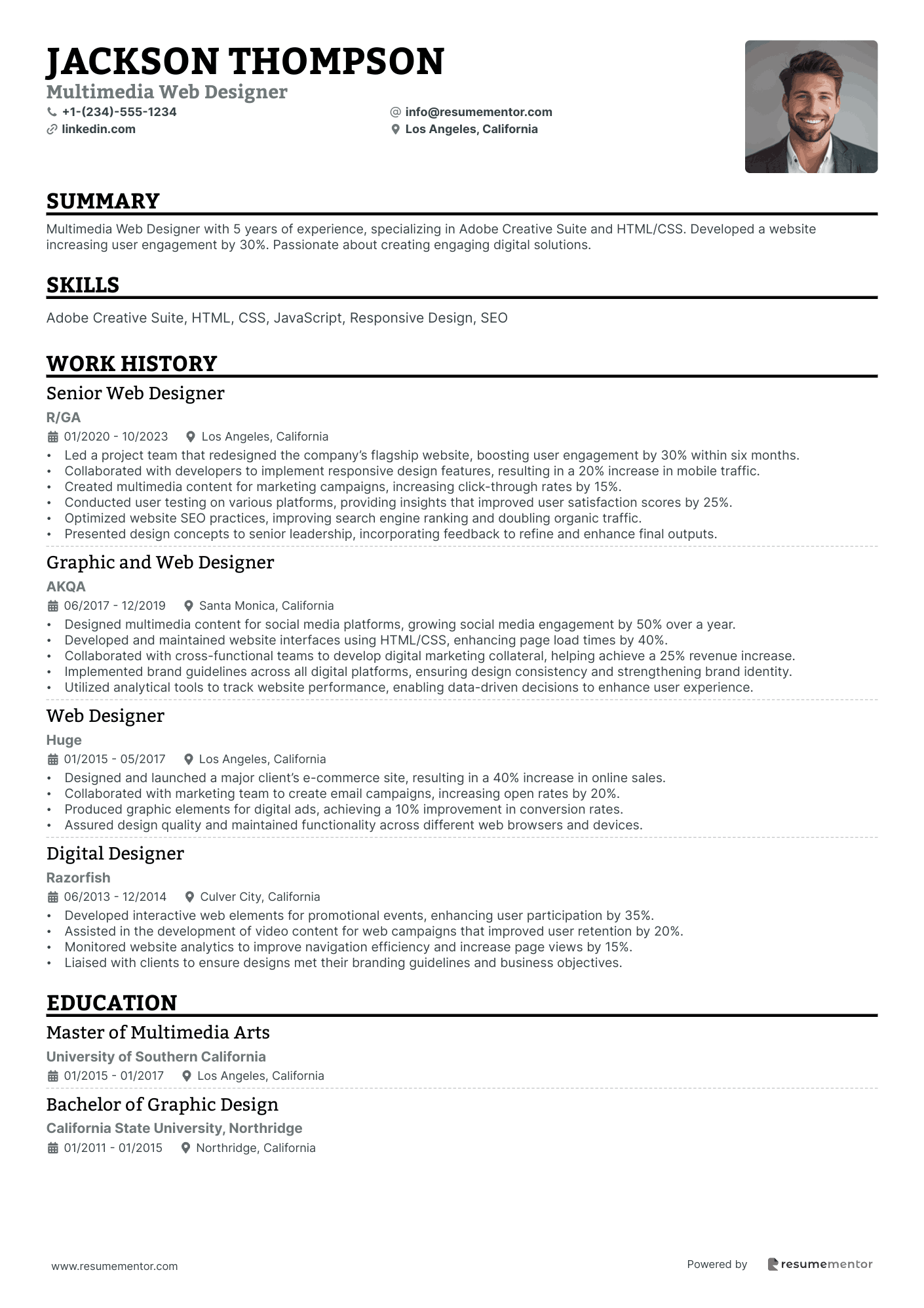
Multimedia Web Designer
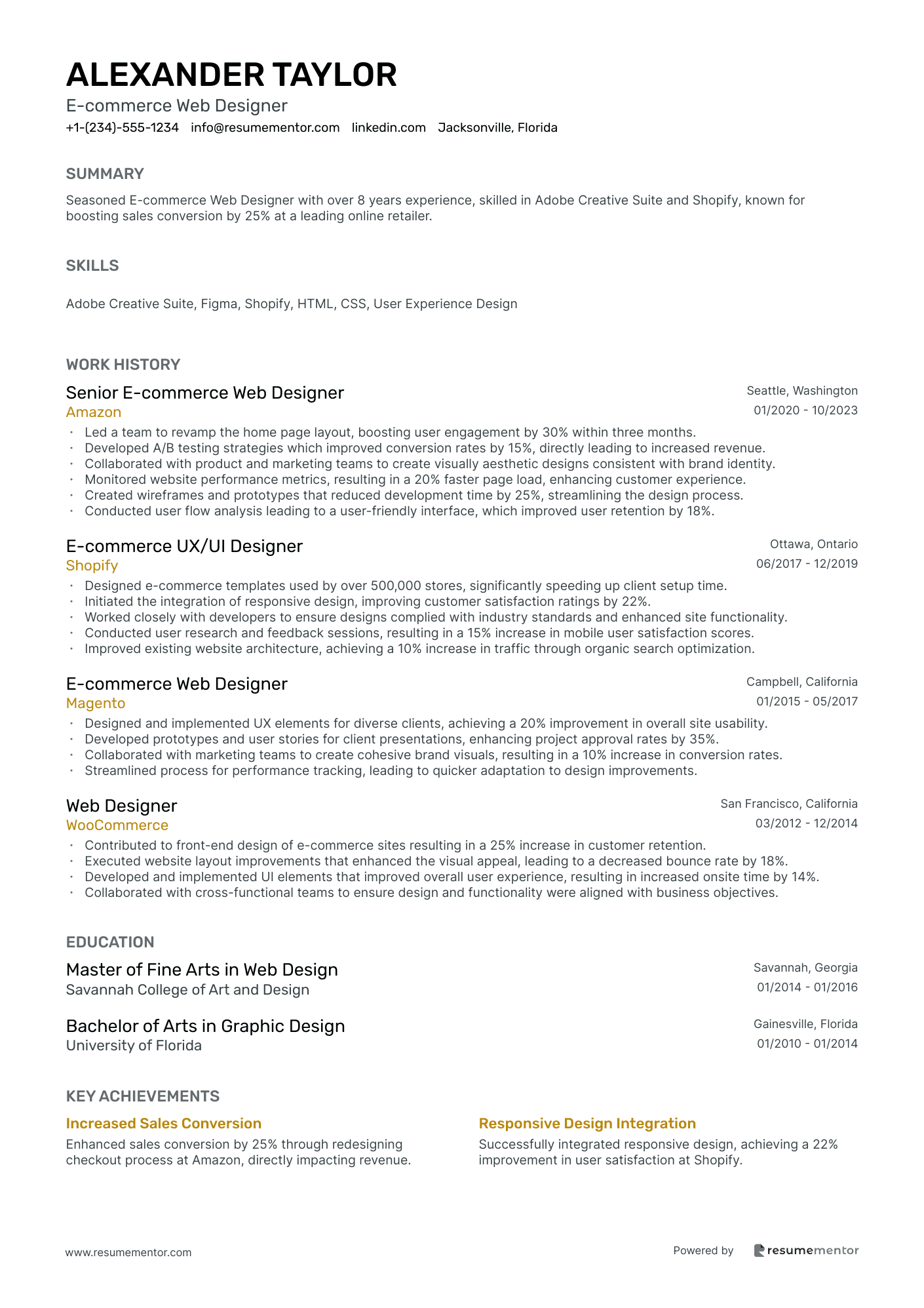
E-commerce Web Designer
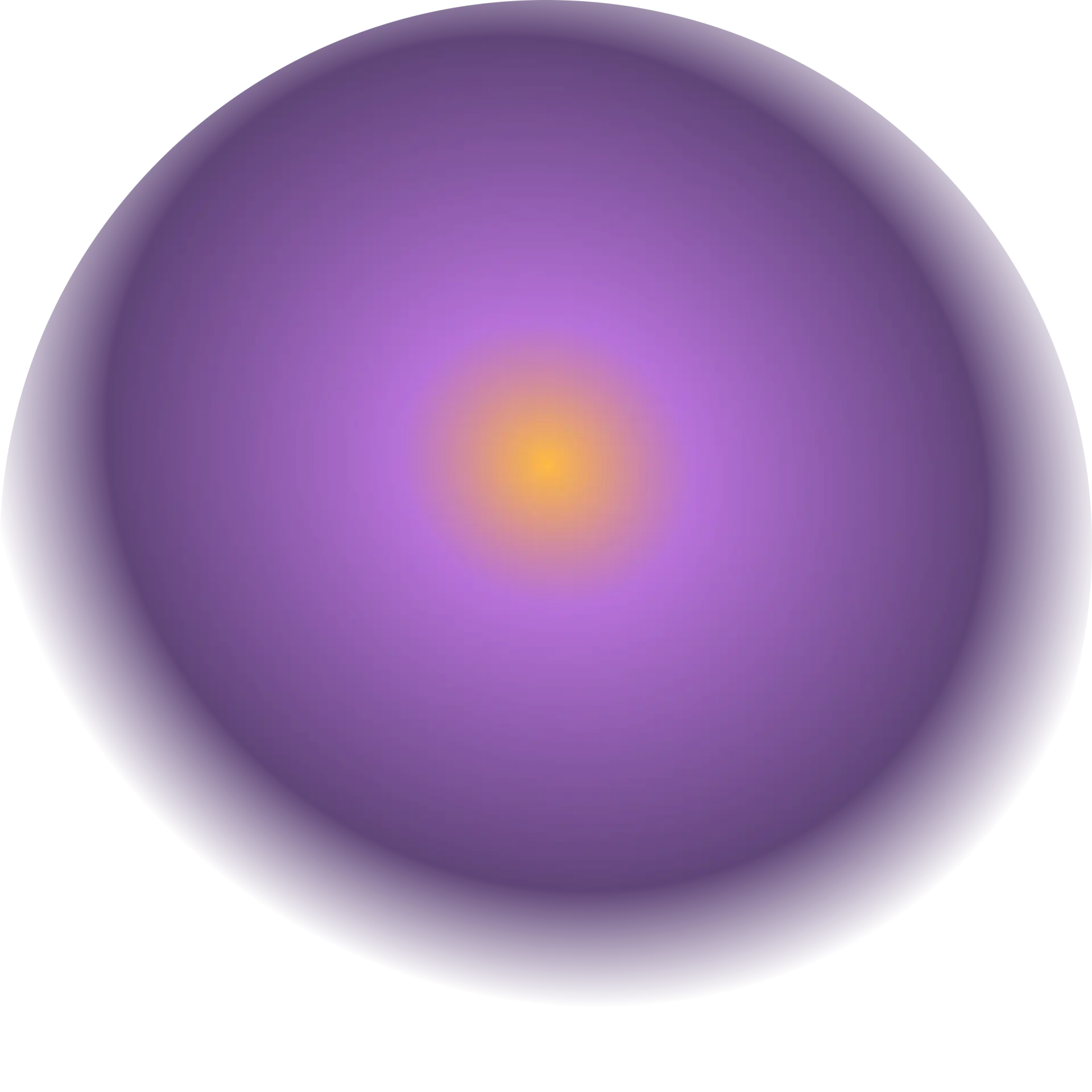
User Interface Designer resume sample
- •Led a team of designers to revamp an enterprise software interface, boosting usability scores by 30%.
- •Spearheaded a redesign project resulting in a 25% increase in user engagement and enhanced client satisfaction.
- •Collaborated with UX researchers to conduct user testing, refining designs based on 200+ feedback points.
- •Developed a comprehensive UI design guide that standardized visual elements, improving consistency by 40%.
- •Implemented an agile design process which reduced project timelines by 20% and increased team productivity.
- •Presented design concepts to executive stakeholders, achieving approval for over 90% of proposed changes.
- •Designed interactive dashboards that improved reporting accuracy by 15% and user satisfaction by 20%.
- •Created high-fidelity prototypes that assisted developers in reducing front-end development time by 30%.
- •Managed multiple design projects concurrently, delivering 95% within budget and timeline constraints.
- •Collaborated in cross-functional teams to align design strategies with corporate goals, enhancing product coherence.
- •Instituted monthly design reviews, leading to iterative improvements and sustained UX enhancements.
- •Reconstructed mobile game interfaces that increased user retention rates by 10% in the first six months.
- •Developed and implemented a new iconography system, facilitating a 25% faster user onboarding process.
- •Orchestrated team workshops to ideate and generate innovative solutions, boosting creativity by 40%.
- •Enhanced web application interactivity, resulting in a 5-star review increase by 15% on major platforms.
- •Executed outdoor advertising campaigns that successfully elevated client brand visibility by 35%.
- •Redesigned print collateral which improved engagement rates by 20% at client events and trade shows.
- •Cultivated a streamlined design workflow that improved output efficiency by 25%, benefiting the design team.
- •Assisted in the creation of client presentation materials, increasing pitch success rate by 15%.
Graphic Web Designer resume sample
- •Developed 30+ responsive designs that improved mobile user experience, resulting in a 25% increase in mobile engagement.
- •Collaborated with marketing teams to align design strategies, ensuring a 15% rise in campaign effectiveness and customer retention.
- •Utilized Adobe Suite to produce high-quality graphics, enhancing visual storytelling on client-facing digital platforms by 40%.
- •Conducted user research and implemented feedback for design adjustments, which lowered bounce rates by 18% across key projects.
- •Coordinated with developers to maintain design accuracy, facilitating troubleshooting and reducing implementation errors by 12%.
- •Managed multiple projects under tight deadlines, delivering all projects on time while maintaining 100% design quality adherence.
- •Led the redesign of the company website, improving navigation and design integration, leading to a 30% increase in page views.
- •Worked closely with SEO experts, integrating strategies that improved search rankings by 20%, boosting organic traffic significantly.
- •Implemented design changes in collaboration with stakeholders, which increased user satisfaction scores by 15% in post-design surveys.
- •Produced digital assets for marketing campaigns, contributing to a 12% increase in lead conversions during key sales pushes.
- •Ensured brand consistency across all designs, maintaining visual alignment with corporate identity across multiple online platforms.
- •Developed intuitive UX prototypes that reduced user path complexity by 40%, streamlining customer navigation and interaction.
- •Led UX testing sessions which identified navigation issues, leading to targeted improvements and a 15% increase in user flow efficiency.
- •Worked with cross-functional teams to integrate design changes, aligning development and marketing efforts seamlessly.
- •Created visually appealing content for various platforms, increasing brand engagement and enhancing visual storytelling efforts.
- •Designed diverse digital assets that were integral to several successful product launches, increasing market visibility by 25%.
- •Collaborated on multimedia projects that supported vital marketing strategies, enhancing overall campaign effectiveness.
- •Produced design elements for print and digital use, ensuring brand cohesiveness across all communication channels.
- •Participated in brainstorming and creative sessions significantly contributing to forward-thinking marketing solutions.
Mobile Web Designer resume sample
- •Designed mobile web interfaces that increased user engagement by 40%, capturing feedback and iterating designs accordingly.
- •Collaborated with a cross-functional team to define user requirements, resulting in a 30% improvement in user satisfaction scores within one year.
- •Developed prototypes and visual designs adhering to brand guidelines, leading to an increase of brand consistency by 50%.
- •Led usability testing sessions that identified critical design issues, achieving a 25% reduction in user drop-off rates.
- •Managed multiple design projects simultaneously and delivered within deadlines, improving project delivery efficiency by 20%.
- •Worked closely with developers to ensure the accurate implementation of designs, which enhanced the overall product quality by 15%.
- •Contributed to a major redesign project that increased mobile user retention by 28% across varying screen sizes.
- •Created wireframes and prototypes that aligned with business goals, leading to a 27% rise in product launches.
- •Executed user research methods to gather insights, improving user interface satisfaction ratings by 22%.
- •Optimized design responsiveness across mobile devices, reducing customer service queries related to interface issues by 35%.
- •Implemented new design trends and technologies that kept mobile applications current, boosting user adoption rates by 18%.
- •Designed user-friendly mobile web applications that secured a 45% increase in user engagement.
- •Ensured design consistency, which resulted in a 38% gain in customer loyalty and repeat visits.
- •Collaborated with a team to implement designs successfully, enhancing the company’s digital footprint by 32%.
- •Streamlined the design process to reduce development time by 25%, speeding up the project delivery timeline.
- •Participated in the design of a mobile application that boosted downloads by 56% within the first six months.
- •Created innovative design solutions that accounted for a 20% better user interface experience.
- •Improved site usability, which reduced user complaints by 30% over a six-month period.
- •Collaborated with teams to integrate visually appealing designs that increased brand recognition by 25%.
UX/UI Web Designer resume sample
- •Developed and implemented user personas and journey maps that increased user engagement by 20% over the first year.
- •Designed high-fidelity prototypes with Figma, resulting in a 30% faster feedback cycle with cross-functional teams.
- •Conducted over 50 usability tests, gathering insights to enhance the overall experience, leading to a 15% reduction in user error.
- •Collaborated with developers to ensure seamless integration of designs, therefore improving page load times by 25%.
- •Generated a cohesive visual language across multiple applications, achieving a 98% consistency rate in brand representation.
- •Informed design strategies through continuous research and trend analysis, boosting customer satisfaction scores by 10%.
- •Led the redesign of a major mobile application interface, increasing user retention by a remarkable 25% within six months.
- •Implemented design systems that streamlined development efforts, reducing time to market by approximately 20%.
- •Facilitated workshops for stakeholders, fostering alignment on user-centric objectives that resulted in higher project satisfaction.
- •Executed A/B testing for different design iterations, bringing down bounce rates on landing pages by 15%.
- •Integrated responsive design principles into existing products, enhancing accessibility and user engagement across devices.
- •Collaborated with cross-functional teams to craft intuitive web interfaces, increasing client base by 30% over two years.
- •Resolved user feedback loopholes by upgrading UX design, leading to a noticeable 12% decrease in customer complaints.
- •Presented design frameworks in meetings, effectively translating complex ideas into actionable solutions for developers.
- •Consistently exceeded project deadlines by applying efficient wireframing and prototyping techniques using Sketch and Adobe XD.
- •Designed dynamic and engaging visual content for web applications, which improved user interactions by 18% year-over-year.
- •Championed the creation of a clean user interface look that was adopted across multiple projects, boosting consistency.
- •Conducted competitor analysis studies to inform design decisions, therefore staying at the forefront of industry standards.
- •Mentored junior designers, resulting in a 40% increase in team productivity and design output quality.
Interactive Web Designer resume sample
- •Designed and launched a new website interface for e-commerce client, improving average order value by 25% through user-friendly design enhancements.
- •Led a project to create a responsive design solution, achieving a 40% reduction in bounce rates across mobile devices.
- •Collaborated closely with development team to introduce an interactive feature that increased user dwell time by 30%.
- •Streamlined the feedback process with stakeholders, resulting in a 50% faster project turnaround time.
- •Played a pivotal role in a cross-functional team to develop an award-winning campaign, contributing to a client revenue increase of $500,000.
- •Integrated new UX/UI trends into existing projects, consistently improving user satisfaction scores by 20%.
- •Redesigned company website, boosting page load speed by 50%, enhancing user experience significantly.
- •Initiated a platform redesign that improved conversion rates by 15% through improved navigation structure.
- •Developed dynamic content that achieved a 25% increase in time-on-site for major marketing campaigns.
- •Contributed to a design refresh for a leading retail client, resulting in a sales uplift of over 10%.
- •Conducted regular A/B testing to refine user interfaces, leading to a 35% increase in user retention.
- •Supported redesign tasks resulting in a 30% reduction in project timelines by optimizing work flow strategies.
- •Crafted visually appealing prototypes that boosted client approval ratings to 90% on first review.
- •Facilitated training sessions for team on the latest Adobe Creative Suite functionalities, enhancing team productivity by 20%.
- •Implemented design revisions based on user feedback, increasing customer satisfaction ratings by 15%.
- •Assisted in the development of interactive features, contributing to a 20% increase in user interaction for a client site.
- •Organized cross-department workshops enhancing collaborative efforts, resulting in a more cohesive web design workflow.
- •Researched and implemented web accessibility standards, improving site compliance and accessibility by 40%.
- •Contributed to design projects that supported a 15% growth in client base through engaging digital experiences.
Responsive Web Designer resume sample
- •Designed and launched 15+ responsive websites, improving user engagement by 30% through intuitive layouts and design consistency.
- •Collaborated with multi-disciplinary teams to enhance product designs, resulting in a 15% increase in design process efficiency.
- •Led user research initiatives for various projects, integrating feedback that elevated overall user satisfaction by 25%.
- •Spearheaded the design system's overhaul, ensuring a cohesive visual language across digital platforms.
- •Mentored junior designers and facilitated design reviews, improving team design output by 20%.
- •Developed interactive prototypes with Figma, enhancing communication with developers and stakeholders.
- •Produced 20+ mockups for new web products, which helped reduce bounce rates by an average of 15%.
- •Worked closely with developers to implement HTML/CSS frameworks, ensuring project deadlines were met consistently.
- •Engaged in cross-functional meetings to define project requirements, resulting in more targeted and effective design solutions.
- •Conducted extensive competitive analysis, informing design decisions that improved site ranking by 10 positions.
- •Maintained and updated the design system library, facilitating better resource management and design consistency.
- •Redesigned key web interfaces, which contributed to a 20% increase in user retention rates.
- •Executed A/B testing on design elements, providing valuable insights that enhanced product usability.
- •Collaborated with UX researchers to gather user feedback, inspiring design revisions that aligned with user needs.
- •Optimized website design for mobile devices, increasing mobile traffic by 40%.
- •Developed and revised wireframes for new web pages, ensuring a seamless user experience across platforms.
- •Worked directly with marketing teams to ensure brand consistency across digital designs.
- •Incorporated modern web design trends, which resulted in a 15% increase in user engagement.
- •Managed multiple projects under tight deadlines while maintaining high-quality standards.
Digital Web Designer resume sample
- •Led the design of a responsive website, resulting in a 30% increase in user engagement and a 20% boost in customer retention.
- •Collaborated with developers to refine the design system, enhancing consistency across digital platforms and optimizing load times by 15%.
- •Implemented a new mobile design strategy that increased mobile traffic by 45% and mobile conversion rates by 25%.
- •Conducted usability testing and user research, improving the user interface by reducing onboarding time by 40% for new users.
- •Created a brand-focused design for a product landing page, achieving a 50% increase in lead generation and exceeding KPI targets.
- •Managed and prioritized multiple design projects, consistently meeting tight deadlines while maintaining a customer satisfaction rate of 95%.
- •Redesigned corporate site interface leading to a 25% decrease in bounce rate and a smoother navigation experience.
- •Spearheaded the design of interactive client presentations, resulting in a 15% higher client engagement score and more effective communication.
- •Utilized Figma to streamline the prototyping process, cutting design time by 30% while maintaining quality and meeting client expectations.
- •Participated in cross-functional team workshops, fostering innovation and improving design solutions that aligned with user-centric goals.
- •Introduced new branding guidelines, achieving a 20% improvement in brand consistency across all digital marketing materials.
- •Developed user-friendly interfaces that enhanced accessibility, increasing user satisfaction by 18% and expanding the customer base.
- •Worked closely with the marketing team to launch a major campaign, increasing web traffic by 60% within the first month.
- •Participated in user journey mapping sessions which resulted in a streamlined checkout process, improving conversion rates by 10%.
- •Designed email marketing templates that achieved a 25% higher open rate and increased click-through rates by 12%.
- •Created visually compelling digital content that increased social media engagement by 40%, boosting brand awareness.
- •Produced high-quality graphics and web designs which consistently aligned with brand guidelines and contributed to a 15% increase in sales.
- •Regularly updated knowledge of design tools, leading to the adoption of innovative techniques that improved design quality and speed.
Multimedia Web Designer resume sample
- •Led a project team that redesigned the company’s flagship website, boosting user engagement by 30% within six months.
- •Collaborated with developers to implement responsive design features, resulting in a 20% increase in mobile traffic.
- •Created multimedia content for marketing campaigns, increasing click-through rates by 15%.
- •Conducted user testing on various platforms, providing insights that improved user satisfaction scores by 25%.
- •Optimized website SEO practices, improving search engine ranking and doubling organic traffic.
- •Presented design concepts to senior leadership, incorporating feedback to refine and enhance final outputs.
- •Designed multimedia content for social media platforms, growing social media engagement by 50% over a year.
- •Developed and maintained website interfaces using HTML/CSS, enhancing page load times by 40%.
- •Collaborated with cross-functional teams to develop digital marketing collateral, helping achieve a 25% revenue increase.
- •Implemented brand guidelines across all digital platforms, ensuring design consistency and strengthening brand identity.
- •Utilized analytical tools to track website performance, enabling data-driven decisions to enhance user experience.
- •Designed and launched a major client’s e-commerce site, resulting in a 40% increase in online sales.
- •Collaborated with marketing team to create email campaigns, increasing open rates by 20%.
- •Produced graphic elements for digital ads, achieving a 10% improvement in conversion rates.
- •Assured design quality and maintained functionality across different web browsers and devices.
- •Developed interactive web elements for promotional events, enhancing user participation by 35%.
- •Assisted in the development of video content for web campaigns that improved user retention by 20%.
- •Monitored website analytics to improve navigation efficiency and increase page views by 15%.
- •Liaised with clients to ensure designs met their branding guidelines and business objectives.
E-commerce Web Designer resume sample
- •Led a team to revamp the home page layout, boosting user engagement by 30% within three months.
- •Developed A/B testing strategies which improved conversion rates by 15%, directly leading to increased revenue.
- •Collaborated with product and marketing teams to create visually aesthetic designs consistent with brand identity.
- •Monitored website performance metrics, resulting in a 20% faster page load, enhancing customer experience.
- •Created wireframes and prototypes that reduced development time by 25%, streamlining the design process.
- •Conducted user flow analysis leading to a user-friendly interface, which improved user retention by 18%.
- •Designed e-commerce templates used by over 500,000 stores, significantly speeding up client setup time.
- •Initiated the integration of responsive design, improving customer satisfaction ratings by 22%.
- •Worked closely with developers to ensure designs complied with industry standards and enhanced site functionality.
- •Conducted user research and feedback sessions, resulting in a 15% increase in mobile user satisfaction scores.
- •Improved existing website architecture, achieving a 10% increase in traffic through organic search optimization.
- •Designed and implemented UX elements for diverse clients, achieving a 20% improvement in overall site usability.
- •Developed prototypes and user stories for client presentations, enhancing project approval rates by 35%.
- •Collaborated with marketing teams to create cohesive brand visuals, resulting in a 10% increase in conversion rates.
- •Streamlined process for performance tracking, leading to quicker adaptation to design improvements.
- •Contributed to front-end design of e-commerce sites resulting in a 25% increase in customer retention.
- •Executed website layout improvements that enhanced the visual appeal, leading to a decreased bounce rate by 18%.
- •Developed and implemented UI elements that improved overall user experience, resulting in increased onsite time by 14%.
- •Collaborated with cross-functional teams to ensure design and functionality were aligned with business objectives.
Embarking on a job search as a web designer can feel like navigating a complex web of code. While your creativity and technical skills should shine, transferring that brilliance onto a resume can feel overwhelming. Condensing your artistic flair and digital expertise into a concise document that captures an employer's attention is a fine art in itself.
Highlighting your skills—like mastering design software and creating visually stunning websites—is crucial. Here’s where a resume template can be invaluable. It provides the structure you need, allowing you to focus on showcasing what really counts—your talents and achievements. Explore these resume templates to find a solid foundation for your unique resume as a web designer.
Think of your resume as a personal canvas, where creativity meets clarity. This is your opportunity to craft a cohesive story about your web design journey, making it as engaging and attractive as the sites you create. With a well-crafted resume, your abilities and successes can come to life, showing employers why you're the best fit.
Writing a resume isn't just a formality; for a web designer, it's an art form that reflects your knack for turning ideas into digital masterpieces. Let’s dive into crafting a resume that opens doors and compellingly tells your story.
Key Takeaways
- When crafting a web designer resume, it's crucial to highlight both your design skills, such as expertise in software like Adobe Creative Suite, and your ability to create visually appealing and functional websites.
- Structure your resume with clear sections including contact information, a professional summary, work experience, education, skills, and certifications relevant to web design.
- Choose a clean and simple format for your resume, with careful attention to fonts and spacing, and always save it as a PDF to maintain a consistent and professional appearance.
- Your experience section should focus on quantifiable achievements, using active language and specific examples to showcase your impact in previous roles.
- In addition to technical skills, make sure to include soft skills and extra sections like languages, hobbies, and volunteer work to give a well-rounded view of your professional and personal attributes.
What to focus on when writing your web designer resume
As a web designer, your resume should clearly communicate your design expertise and versatility to capture the recruiter's attention—it's essential to emphasize your ability to craft user-friendly, visually appealing, and functional websites. Demonstrating a solid grasp of essential design tools and staying updated with design trends sets the foundation for a compelling resume, showcasing your value from the start.
How to structure your web designer resume
- Contact Information — Begin with your full name, phone number, and professional email. Providing a link to your online portfolio is crucial as it offers a visual representation of your skills and projects, which is invaluable in the design world, giving recruiters a quick, immersive look at your capabilities and creative style.
- Professional Summary — Craft a concise statement that not only highlights your web design skills but also reflects your distinct approach and experience. Mentioning specific design software like Adobe Creative Suite or Sketch adds depth to your profile, indicating both your technical prowess and your ability to translate ideas into user-centric designs effortlessly.
- Skills — A well-organized skills section should be more than a simple list. It should encompass relevant abilities such as HTML, CSS, JavaScript, UX/UI principles, and responsive design, aligning your expertise with the job description and underscoring your adaptability as a designer ready to meet the company's needs.
- Work Experience — Detail your recent roles by emphasizing achievements and tangible results, such as increased engagement or improved website performance. Clearly defining job titles, company names, and employment dates allows for easy navigation through your professional journey, creating a coherent narrative of growth and success that supports your candidacy.
- Education — Provide information about your degree in web design or a related field, ensuring to include the institution's name and your graduation date as this reinforces your foundational knowledge and dedication to formal learning, offering a solid base for your practical skills.
- Certifications — Adding industry-relevant certifications, like Certified Web Designer or UX Design certifications, serves to bolster your expertise and show an ongoing commitment to professional development, distinguishing you as a proactive and knowledgeable candidate.
With each of these sections in place, below we'll cover how to effectively structure the resume format for maximum impact.
Which resume format to choose
Creating a standout resume is essential for a web designer, and it begins with a clear and simple format that effectively highlights your skills and experiences. As someone who designs for a living, your resume should reflect your eye for detail and aesthetics. Choosing the right font is part of this design process; opt for Rubik for its sleek readability, select Lato for a professional yet approachable vibe, or choose Montserrat for a bold, contemporary touch. These modern fonts subtly elevate your resume beyond the standard choices, hinting at your awareness of design trends.
Equally vital is saving your resume as a PDF. As a web designer, you understand the importance of preserving your work's integrity, and PDFs ensure your resume's design remains consistent and professional across different devices and software. This format reflects the reliability and professionalism you bring to your projects.
Setting your margins to about one inch on all sides plays a crucial role in creating a neat and readable document. This bit of design work ensures there is enough white space to avoid overwhelming the reader with text, which echoes the principles of good web design. Well-balanced margins guide the reader's eye comfortably through your resume, making it easier to focus on your key achievements and skills. By incorporating these elements, your resume serves as a true reflection of your expertise and creativity as a web designer.
How to write a quantifiable resume experience section
Your resume's experience section is the heart of your professional journey, especially as a web designer, where showcasing your skills and achievements is key. Start with your most recent positions because employers are most interested in your latest work, making it easier for them to see your current capabilities. Limit your history to the past 10-15 years unless older experiences are highly relevant, ensuring everything you list resonates with the job you're targeting. Tailoring each entry to the specific job description you’re eyeing means using relevant keywords to put a spotlight on your most applicable experiences. Words like "designed," "developed," "increased," and "optimized" not only grab attention but also underscore your significant contributions.
Here's a cohesive web designer resume experience section:
- •Boosted user engagement by 35% with a redesigned website UI/UX.
- •Directed a team of 5 designers, improving project efficiency by 20% using agile methods.
- •Developed mobile-friendly features that increased mobile traffic by 50%.
- •Worked with cross-functional teams to enhance website functionality, raising client satisfaction by 25%.
This experience section seamlessly illustrates your achievements with clear metrics that showcase your impact in each role. By focusing on increasing engagement, leading teams to more efficient work, and utilizing modern techniques, it forms a comprehensive narrative that appeals to potential employers. Each point not only demonstrates your skills in design and management but also highlights your ability to collaborate and achieve results, making your resume highly relevant and compelling.
Achievement-Focused resume experience section
A web designer achievement-focused resume experience section should emphasize the impact of your work rather than just listing your responsibilities. Highlight how your design efforts have made a noticeable difference in the projects you've taken on or the companies you've worked for. For instance, instead of simply stating that you designed websites, describe how your innovative solutions improved user engagement by 30%. It’s important to use measurable results to illustrate the scale of your achievements and, when possible, mention any accolades or recognitions that further establish your credibility.
Reflect on projects where your design skills truly shined, and think about the ways in which your work enhanced user experiences or contributed to increased website traffic. It's also crucial to consider your collaborative efforts, such as moments when you successfully worked with a team or led a major design initiative. Clearly explain the challenges you faced and how your solutions provided tangible benefits to the organization. Use action-oriented language for each bullet point to effectively communicate your accomplishments in a way that flows naturally and makes a strong impact.
Web Designer
Innovative Solutions Inc., a top web design firm.
June 2020 – Present
- Improved website user engagement by 35% through strategic redesign and user-focused enhancements.
- Led a team of 5 designers in creating over 50 client websites, resulting in a 40% increase in client satisfaction scores.
- Reduced page load times by 20%, leading to enhanced performance and better user retention.
- Awarded 'Designer of the Year' for innovative design solutions that significantly boosted client portfolios.
Skills-Focused resume experience section
A skills-focused web designer resume experience section should clearly demonstrate your practical abilities and professional accomplishments. Start by showcasing key skills vital to web design, like proficiency in HTML, CSS, and JavaScript, and weave these into your narratives about past roles. Describe your experience through the lens of specific projects that highlight your ability to work collaboratively, design user-friendly interfaces, and ensure site responsiveness.
Organize your achievements using bullet points for clarity and impact. Each bullet should tell a story of success, preferably with measurable outcomes that emphasize the value of your skills. For example, you might highlight a website redesign that increased user engagement or a team project that improved site traffic. These examples underscore your potential to deliver tangible benefits to employers. Be sure to format this section for easy readability, allowing your achievements to stand out vividly.
Web Designer
Self-Employed
June 2019 - Present
- Designed and created ten custom websites using HTML, CSS, and JavaScript, leading to a 35% increase in client acquisition.
- Improved website load time by 40% through optimized image handling and streamlined code on multiple projects.
- Collaborated with graphic designers and other developers to create seamless UX/UI experiences, enhancing customer satisfaction by 25%.
- Successfully migrated five client websites to a new CMS platform, decreasing maintenance requests by 20%.
Technology-Focused resume experience section
A technology-focused web designer resume experience section should effectively highlight your skills and achievements. Begin with your most recent job, including the dates of employment, and mention your job title alongside the company's name. Use bullet points to delve into your role, focusing on how you contributed and what you accomplished. By using active verbs and specifying the tools and technologies you employed, you create a vivid picture of your capabilities.
To enhance the appeal of your resume, align your experience section with the job you're targeting. Quantifying achievements with numbers, like improvement in user engagement or efficiency gains, makes your impact clear and tangible. Ensure that each bullet point connects to your overarching narrative of being a skilled web designer adept at leveraging technology to drive results, making sure the entire section is cohesive and easy to follow.
Senior Web Designer
Tech Innovators
June 2021 - Present
- Redesigned the company website, enhancing user experience and increasing visitor duration by 35%.
- Worked closely with teams to implement responsive design, cutting mobile bounce rates by 50%.
- Led a group of 4 designers to migrate site content to a new CMS, reducing page load times by 20%.
- Integrated a JavaScript feedback system that boosted user interaction by 15%.
Customer-Focused resume experience section
A customer-focused web designer resume experience section should highlight your ability to create user-friendly interfaces that enhance client satisfaction. Begin by focusing on the skills and experiences that demonstrate your expertise in listening to client needs and transforming them into effective design solutions. Use clear, active language to convey your contributions, linking each achievement to the improvements they brought about. It’s essential that your bullet points illustrate how your creativity and problem-solving skills have driven user engagement and satisfaction.
To effectively showcase your customer-focused skills, provide concrete examples of how you've successfully turned client feedback into high-performing designs. Each example should illustrate not just what you did, but how it made a difference in user interactions or client happiness. Clearly describe your role and responsibilities, ensuring that each bullet connects the dots between your efforts and the benefits to clients or users, supported by tangible results.
Freelance Web Designer
June 2020 - Present
- Created over 20 user-friendly websites that improved client engagement by an average of 30%.
- Consulted with clients to refine design preferences, ensuring alignment with brand image and objectives.
- Implemented responsive designs to enhance accessibility and user experience across all devices.
- Collaborated with developers to streamline functional design, reducing page load time by 25%.
Write your web designer resume summary section
A skill-focused web designer resume summary should effectively highlight your experience and core competencies. It offers a chance to set you apart by showcasing what makes you unique in your field. Emphasizing skills tailored to the job is key. When you include specific achievements or metrics, it adds weight to your claims. For instance, consider a resume summary like this:
This example ties together experience, technical skills, and leadership. It clearly communicates your value by detailing how you improved client engagement by 30%, making your impact tangible. Highlighting teamwork and leadership further strengthens your personal brand.
When choosing words to describe yourself, terms like "dynamic," "motivated," or "dedicated" can convey enthusiasm and passion. Emphasizing the impact you can make ensures hiring managers see the full picture of your potential. Tailor this part to align with the targeted role.
Understanding different resume sections can enhance your presentation. A resume summary succinctly outlines your career highlights. On the other hand, a resume objective focuses on career aspirations and is ideal for those with less experience. A resume profile merges summary and objective elements, providing a fit for the job at hand. Lastly, a summary of qualifications encapsulates key skills and achievements in list form. Adapting your summary or objective based on your experience level ensures alignment with your career stage and the job you're pursuing.
Listing your web designer skills on your resume
A skills-focused web designer resume should revolve around how you present both your technical abilities and personal attributes. The skills section is crucial, whether it stands alone or blends into areas like experience and summary. Highlighting your strengths and soft skills puts the spotlight on how well you interact with others and tackle challenges. In contrast, hard skills are your specific technical capabilities, like coding or using design tools, and these serve as essential keywords that help your resume catch the eye of employers.
Here's an example of how you can format this section:
This example is effective because it includes skills closely aligned with web design demands. By using clear, targeted terms that employers look for, you're more likely to make your resume stand out. Detailing a mix of hard skills not only showcases your technical know-how but also illustrates your adaptability across different projects.
Best hard skills to feature on your web designer resume
As a web designer, focusing on hard skills is key. These demonstrate your ability to create websites that are both visually engaging and efficient. Highlighting these skills shows your technical prowess and creative flair. Include these sought-after hard skills:
Hard Skills
- HTML/CSS
- JavaScript
- Responsive Design
- Adobe Creative Suite
- UX/UI Design
- SEO Optimization
- CMS Platforms
- Cross-Browser Compatibility
- Wireframing
- Graphic Design
- Prototyping
- Testing and Debugging
- Web Performance Optimization
- Version Control/Git
- Mobile First Design
Best soft skills to feature on your web designer resume
Equally important are your soft skills, which are vital in team environments. These skills reflect how effectively you communicate, adapt, and manage your time. Consider emphasizing these popular soft skills:
These elements, combined, will help you craft a skills section that enhances your web designer resume, making it both compelling and targeted to what employers are seeking.
Soft Skills
- Creativity
- Attention to Detail
- Communication Skills
- Problem-Solving
- Flexibility
- Team Collaboration
- Time Management
- Customer Service
- Critical Thinking
- Open-Mindedness
- Initiative
- Patience
- Adaptability
- Empathy
- Active Listening
How to include your education on your resume
An education section is an essential part of your web designer resume. It helps employers quickly see your academic qualifications and assess your potential fit for the job. Your education section should be tailored to the job you're applying for; this means including only relevant education. Irrelevant study, which doesn't pertain to web design, can clutter your resume.
Include your GPA if it is impressive and relevant to the position, usually above 3.5 out of 4.0. List your degree clearly on your resume, indicating any honors like cum laude if applicable. Let’s compare a wrong and right example of an education section for a web designer.
The second example is well-suited for a web designer position because it highlights a relevant field of study: graphic design. It also showcases an excellent GPA and cum laude honor, illustrating strong academic performance. It aligns well with the skills needed for web design, which is critical for making your resume stand out.
How to include web designer certificates on your resume
In a web designer's resume, a certificates section is crucial for showcasing your expertise and ongoing professional development. List the name of each certificate clearly. Include the date you received it next to the certificate name. Add the issuing organization to authenticate the credential. Certificates can also be highlighted in the header for immediate visibility. For example, you might write: "Certified UX Designer - Nielsen Norman Group."
Here's a detailed JSON example for a standalone certificates section:
This example is excellent because it includes relevant certificates for a web designer, such as UX Design and Responsive Web Design, showing specialized skills. Listing well-known issuing organizations like Google and freeCodeCamp adds credibility and impresses hiring managers.
Extra sections to include on your web designer resume
Crafting a standout web designer resume can significantly boost your chances of landing your dream job. Aside from listing your technical skills, including thoughtful sections can paint a complete picture of who you are as a professional and individual. A well-rounded resume tells employers more than just the basics.
- Language section — Add any languages you speak fluently because it can highlight your ability to work in diverse environments. It also shows potential employers your versatility and communication skills.
- Hobbies and interests section — Showcase your hobbies to give employers insight into your personality and creativity. This section can help build rapport during interviews by revealing common interests.
- Volunteer work section — Include volunteer experience to emphasize your community involvement and commitment. This helps show your teamwork skills and willingness to give back.
- Books section — List impactful books to reflect continuous learning and curiosity. It indicates that you stay informed about trends and new ideas in web design or related fields.
These sections enrich your resume and help differentiate you from other candidates. Taking the time to carefully craft and include them can offer potential employers a more comprehensive view of what makes you unique. By doing so, you transform your resume into a powerful tool that tells your story.
In Conclusion
In conclusion, crafting a standout resume as a web designer is an opportunity to showcase your unique blend of creativity and technical expertise. By focusing on key components such as a well-structured layout, concrete achievements, and relevant skills, you're telling a compelling story about your professional journey. Incorporating quantifiable achievements, like improved user engagement metrics, strengthens your narrative and demonstrates your real-world impact. As you design your resume, remember the importance of aesthetics and readability. Thoughtful font choices and strategic use of white space can highlight your design sensibilities, making a strong impression on potential employers.
Additionally, including education and certifications provides a solid foundation for your technical knowledge and commitment to lifelong learning. When listing skills, both hard and soft, ensure that they are relevant to the role you're targeting, as this alignment can significantly enhance your chances of standing out in a competitive field. Moreover, don't underestimate the value of extra sections that showcase your personality, such as language proficiency or volunteer work. These can set you apart by presenting a more complete picture of your character and values.
Ultimately, your resume is more than just a document; it’s an extension of your personal brand. It should reflect not just what you've done, but how you approach challenges and contribute creatively in the world of web design. Tailor each application to the specific job, adjusting your resume to highlight the most applicable elements of your experience and skills. Taking these steps ensures your resume is not only a reflection of your professionalism but also a gateway to your next career opportunity.
Related Articles
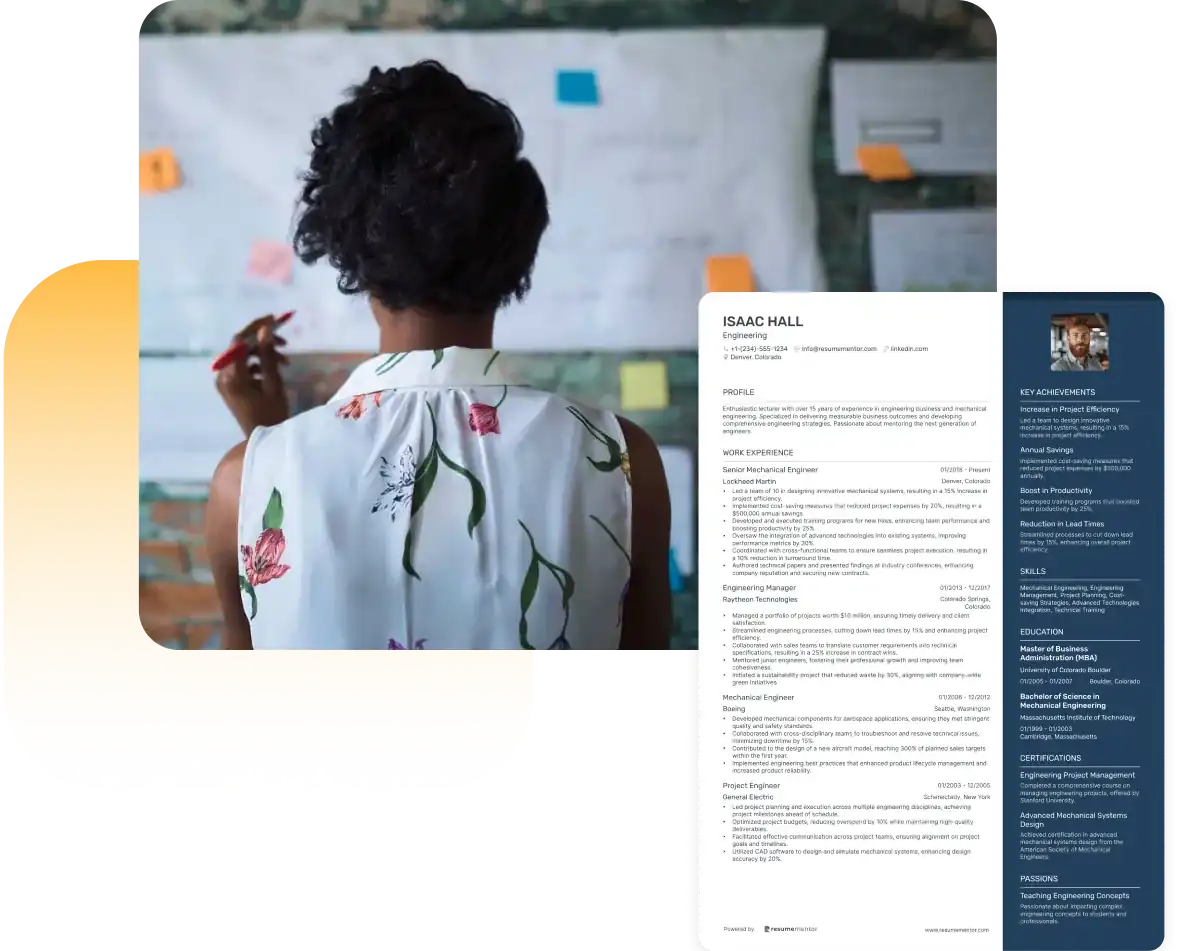
Continue Reading
Check more recommended readings to get the job of your dreams.
Resume
Resources
Tools
© 2025. All rights reserved.
Made with love by people who care.

